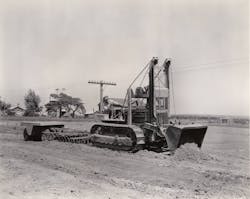The first crawler tractors were primarily used for agriculture and hauling cargo. Their enormous potential in construction was soon realized, and a plethora of attachments and allied machines for use with them came to be offered.
One popular attachment, introduced in the late 1920s, was a loader. Hydraulic technology was far from practical for these machines, so operation was by cables. Probably the most popular of these machines was the Trackson High Loader, offered primarily for Caterpillar tractors.
The final form of the High Loader, shown in this photo, was available for Cat D2s through D7s. The bucket was raised and lowered by a winch enclosed in the housing atop the engine; the winch was driven by a belt from the front power takeoff. Dumping was uncontrolled: The operator pulled a wire at his side to release a trip. To set the bucket for another load, he had to drop the bucket to the ground and back up, or lower it while resting on whatever he had dumped into.
The design was inherently front-heavy and top-heavy, being as it was an attachment for a tractor that was not designed to handle it. Visibility was obviously a problem, especially on the larger models. But it was an excellent digging machine, as the weight tended to fall on the cutting edge of the bucket; it was especially useful for basement excavation, where proper alignment of the loader and a straight lift produced a clean wall.
Van Dobeous perfected the first all-hydraulic loader attachment for Allis-Chalmers affiliate Tractomotive in 1946, and Trackson and Caterpillar quickly adopted the idea on expiration of the patents. In 1953, Caterpillar introduced the No. 6 Shovel, the first all-hydraulic crawler loader built as such from the ground up.
The Historical Construction Equipment Association (HCEA) is a 501(c)3 nonprofit organization dedicated to preserving the history of the construction, dredging and surface mining equipment industries. With over 3,600 members in over a dozen countries, our activities include publication of a quarterly educational magazine, Equipment Echoes; operation of National Construction Equipment Museum and archives in Bowling Green, Ohio; and hosting an annual working exhibition of restored construction equipment. Our next International Convention and Old Equipment Exhibition will be September 22-24, 2023, at the National Construction Equipment Museum in Bowling Green, Ohio. The HCEA is raising funds for construction of a new purpose-built building to house its equipment collection.
Individual annual memberships in the HCEA are $35 within the U.S. and Canada, and $55 elsewhere. We seek to develop relationships in the equipment manufacturing industry, and we offer a college scholarship for engineering and construction management students. Information is available at www.hcea.net, by calling 419.352.5616, or e-mailing [email protected]. Scan the QR Code for information on joining.
About the Author
Tom Berry
Tom Berry is archivist for the Historical Construction Equipment Association (HCEA). Information is available at www.hcea. net, or by calling 419.352.5616 or e-mailing [email protected].
